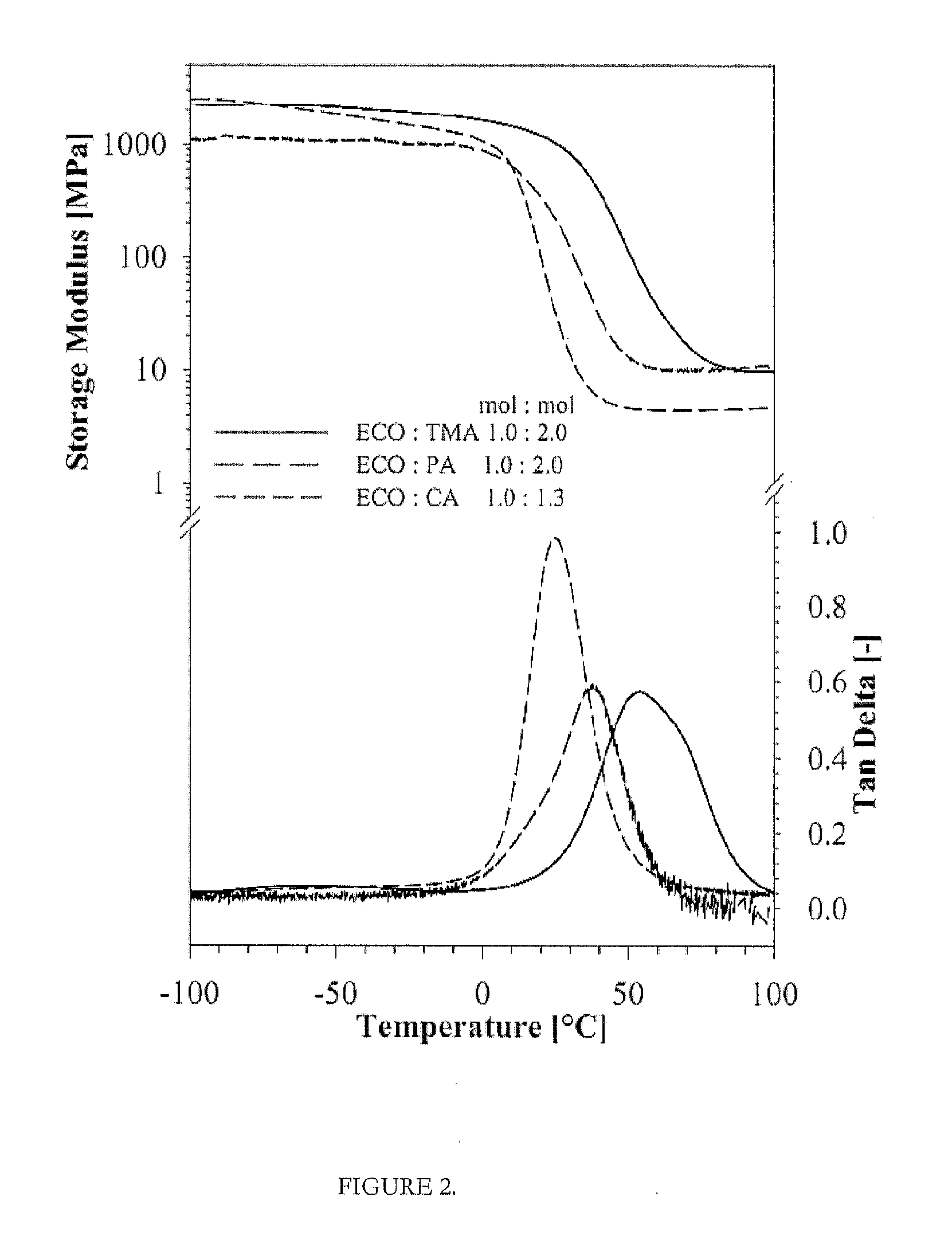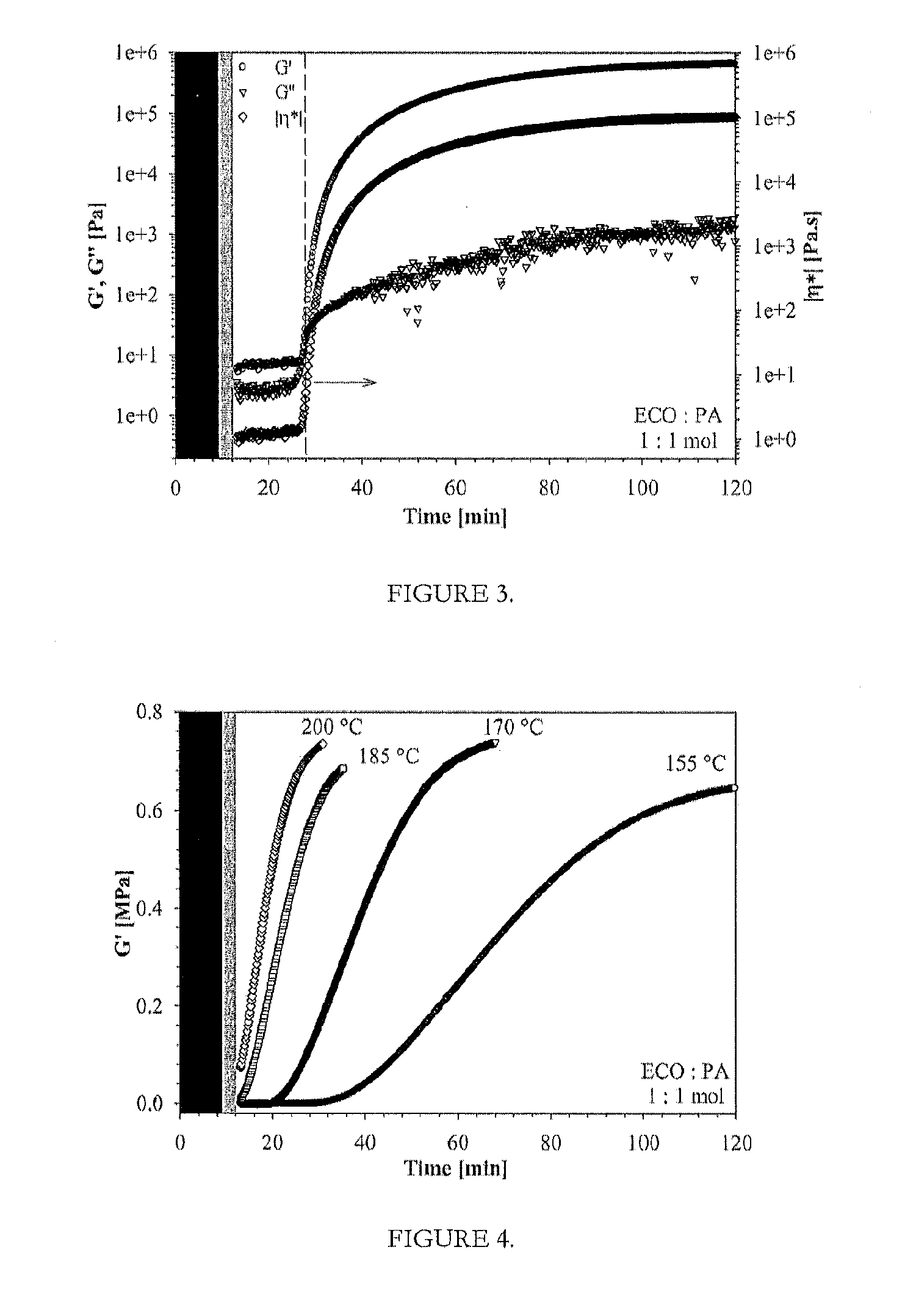Aldehyde free thermoset bioresins and biocomposites
- Summary
- Abstract
- Description
- Claims
- Application Information
AI Technical Summary
Benefits of technology
Problems solved by technology
Method used
Image
Examples
example 1
Epoxidation of Vegetable Oil
[0047]Into a 12 L spherical, jacketed glass reactor, equipped with a bottom drain, and attached to a recirculating liquid cooler, about 2000 g of vegetable oil was loaded at room temperature, and mixed with overhead mechanical stirrer ˜300 rpm. Subsequently, hydrogen peroxide (room temperature, 35%) is added through a funnel. Once the homogeneity of the oil with H2O2 is achieved, formic acid (room temperature, 85%) was added dropwise to the vessel, at a rate of 10-20 g / min. After 1 hour of the mixing, the temperature of the chiller was slowly and continuously increased (at a rate of 10° C. / hour) until the temperature reached 50° C. The epoxidation reaction was allowed to proceed for 20 hours at 50±5° C. under continuous stirring. Completeness of the epoxidation reaction was verified by LC-MS analysis. In all epoxidation processes of different oils, about 0.25 mol of formic acid and 1.4 mol of H2O2 are used for every mole of C═C double bonds in the vegetab...
example 2
100% Biobased Resin of Epoxidized Linseed Oil (ELO) Cured with Citric Acid (CA)
[0048]A desired amount of CA was dissolved in 100 g of solvent (acetone) in a glass flask at a temperature of 50° C. and a desired amount of ELO was added into this mixture. The mixture was thoroughly mixed by a mechanical mixer until a homogeneous mass was obtained. The ratio of ELO / CA was varied in ratios between 1.0:1.0 (0.05 mol:0.05 mol) and 1.0:2.0 mol (0.05 mol:0.10 mol). Stoichiometric ratio of 1:1 of the epoxy and acid groups is generally preferred, and up to 20% more added acid functionality is even more preferred, which increases cure rates and the thermoset polymer may display better mechanical performance. Prepolymer formation and curing of these mixtures were carried out according to the EXAMPLE 3. The final product is thermoset polymer with 100% biobased, renewable content, which can be used in diverse applications.
example 3
Prepolymer Formation and Curing of Bioresins of Epoxidized Oils
[0049]Formation of prepolymers of vegetable oil epoxides with respective curing agents were carried out at 50° C., for about 30 min under continuous mixing, while completely removing the solvent under vacuum with up to 20 mbar. Then, formed prepolymer was transferred into a preheated (60-65° C.) PTFE mold (100×100×6 mm) for further curing. The curing of these neat bioresins were carried out in three steps, at 60-65° C. for 2 hours, at 90-100° C. for 2 hours and at 120-200° C. for 2 hours, as described previously, followed by slow cooling at a rate of 1.0-1.5° C. / min.
PUM
| Property | Measurement | Unit |
|---|---|---|
| Temperature | aaaaa | aaaaa |
| Acidity | aaaaa | aaaaa |
| Thermosetting | aaaaa | aaaaa |
Abstract
Description
Claims
Application Information
 Login to View More
Login to View More - R&D
- Intellectual Property
- Life Sciences
- Materials
- Tech Scout
- Unparalleled Data Quality
- Higher Quality Content
- 60% Fewer Hallucinations
Browse by: Latest US Patents, China's latest patents, Technical Efficacy Thesaurus, Application Domain, Technology Topic, Popular Technical Reports.
© 2025 PatSnap. All rights reserved.Legal|Privacy policy|Modern Slavery Act Transparency Statement|Sitemap|About US| Contact US: help@patsnap.com



